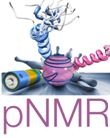Abstract
A network combining 9 academic research groups and 4 collaborating industrial companies is proposed to train the next generation of PhD students and post-doctoral researchers, in developing and applying novel experimental and theoretical methods in the NMR spectroscopy of systems containing paramagnetic metals. The assembled team, with researchers distributed throughout the EU, will investigate a variety of important problems in chemistry and biology including catalysts, battery materials, metalloproteins and large protein-protein assemblies.
The researchers will be trained to attack key problems that prevent the widespread usage of NMR spectroscopy as applied to paramagnetic materials, and to develop new methods to improve significantly the structural and electronic information that can be obtained from these systems.
Three experimental and theoretical work programs are proposed, which build on, but also move significantly beyond the recent advances in pNMR, many of which have originated from members of this network:
i) developing experimental approaches for obtaining NMR spectra from challenging paramagnetic molecules and materials,
ii) extending the fundamental theoretical understanding of pNMR parameters, and facilitating their quantum-chemical implementations in first-principles software;
iii) attacking relevant chemical and biological problems, with novel techniques to determine structure (e.g., of insoluble proteins and disordered battery electrode materials), dynamics and reactivity around metal centres, and exploring interactions between, e.g., biomolecules, catalytic centres and supports.
Integral to the research-based training programme is the series of workshops, practical training courses, international conferences, and outreach actions, located at the different sites.
These will i) train the young researchers of the network in the basics of pNMR and ii) disseminate the results of the network to the larger NMR community and to the general public.
The network has 3 major focuses of research:
Experiments for Theory
The spectra of paramagnetic materials generally contain resonances that are shifted over a large spectral range and often broadened by dipolar interactions and relaxation effects. The goal of this area of research is to develop the NMR tools to obtain quantitative high-resolution spectra of these materials.
There are four general experimental challenges in this field:
- To excite the spin systems, the resonances of which may be spread over an extremely wide spectral range
- To manipulate the spin systems and coherences, which may decay very rapidly due to relaxation effects
- To remove or reduce the various sources of line broadening, and
- To develop novel pulse sequences or methodologies that make use of the specific interactions and relaxation mechanisms inherent to paramagnetic compounds
To overcome these challenges, we propose 4 separate approaches with the following goals:
- To develop new and sensitive liquid- and solid-state NMR approaches to detect spins close to metal centers
- To develop approaches to measure paramagnetic effects quantitatively, and models for studying structure and dynamics from paramagnetic data
- To develop new radio-frequency (rf) schemes and hardware for quantifying paramagnetic effects in solids
- To develop the use of new rigid tags which introduce paramagnetic ions into diamagnetic proteins to assist in the assignment and structural calculation procedures
Theory for Experiments
Paramagnetic interactions contain a wealth of structural, chemical and electronic information. The goal of this area of research is to develop the theoretical approaches with which to analyze the spectra in order to:
- Provide means for improved spectral interpretation for experimental groups
- Extend the underlying physical theory and quantum-chemical implementations
Collaboration between theoretical and experimental groups will allow the extension/application of the methods developed for experiment to a series of model compounds (d-transition metal and lanthanide-containing systems) featuring particular paramagnetic effects and matching the requirements for evaluating different computational approaches: large spin-orbit effects, g-anisotropy, ZFS, low-lying excited states.
Specific approaches for this research include:
- Transformation of the new pNMR shift formalism into a model framework usable for spectra interpretation, and incorporation of low-lying excited states
- Implementation and validation of a fully relativistic four-component approach for pNMR chemical shifts: the case of the lanthanides
- Theory and modeling of spin relaxation
Paramagnetic NMR for chemistry, materials and life sciences
In this research vein, applications will be selected where novel approaches in both experiment and theory are relevant. The ultimate target is to facilitate the pNMR of relevant systems.
To this end, a series of compounds have been chosen, which allow the experimental and theoretical approaches to be implemented:
- Large metalloenymes, either in solution or embedded in membranes
- Oxidation and polymerization catalysts based on paramagnetic metal centers supported on large surface area materials, which are all at the heart of several catalytic processes of relevance for industry, energy and environment
- Inorganic materials for batteries especially novel cathode materials and luminescent nano-objects
- Drug targets, where paramagnetic tags offer an exciting tool to screen a large number of hits, and constitute a fast and cheap alternative to X-ray diffraction to determine the structures of protein targets bound to drug candidate molecules
Specific targets for this research include:
- Reactivity of metal centers at the core of a metalloenzyme
- Protein-ligand and protein-protein interactions as determined via paramagnetic effects
- Protein motions determined through paramagnetic effects
New routes to extend implementations of pNMR shifts for solids and surfaces via full periodic solid-state calculations on surfaces and dense paramagnetic solids: new avenues for materials science and a window on heterogeneous catalysis
